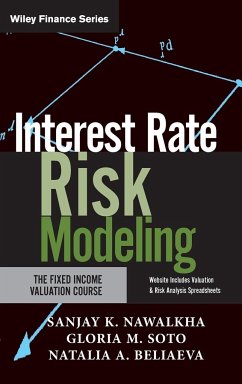Schade – dieser Artikel ist leider ausverkauft. Sobald wir wissen, ob und wann der Artikel wieder verfügbar ist, informieren wir Sie an dieser Stelle.
- Gebundenes Buch
- Merkliste
- Auf die Merkliste
- Bewerten Bewerten
- Teilen
- Produkt teilen
- Produkterinnerung
- Produkterinnerung
The definitive guide to fixed income valuation
Fixed Income Valuation and Risk Analysis comprehensively covers the most definitive work on interest rate risk, term structure analysis, and credit risk in one easy-to-read volume. It examines the latest innovations in this field and provides information on virtually every well-known model used in valuing fixed income securities and derivatives. The companion CD-ROM contains numerous formulas and programming tools that allow readers to better model risk and value fixed income securities. This comprehensive resource provides readers with the…mehr
Andere Kunden interessierten sich auch für
![Pricing Money Pricing Money]() Julian A. WisemanPricing Money92,99 €
Julian A. WisemanPricing Money92,99 €![Investing in Fixed Income Securities Investing in Fixed Income Securities]() Gary StrumeyerInvesting in Fixed Income Securities83,99 €
Gary StrumeyerInvesting in Fixed Income Securities83,99 €![Managing Operational Risk Managing Operational Risk]() Douglas G. HoffmanManaging Operational Risk103,99 €
Douglas G. HoffmanManaging Operational Risk103,99 €![Credit Risk Measurement Credit Risk Measurement]() Anthony SaundersCredit Risk Measurement56,99 €
Anthony SaundersCredit Risk Measurement56,99 €![The Risk Premium Factor, + Website The Risk Premium Factor, + Website]() Stephen D. HassettThe Risk Premium Factor, + Website67,99 €
Stephen D. HassettThe Risk Premium Factor, + Website67,99 €![Risk Transfer Risk Transfer]() Christopher L. CulpRisk Transfer95,99 €
Christopher L. CulpRisk Transfer95,99 €![Foundations of Energy Risk Management Foundations of Energy Risk Management]() Garp (Global Association Of Risk Professionals)Foundations of Energy Risk Management75,99 €
Garp (Global Association Of Risk Professionals)Foundations of Energy Risk Management75,99 €
The definitive guide to fixed income valuation
Fixed Income Valuation and Risk Analysis comprehensively covers the most definitive work on interest rate risk, term structure analysis, and credit risk in one easy-to-read volume. It examines the latest innovations in this field and provides information on virtually every well-known model used in valuing fixed income securities and derivatives. The companion CD-ROM contains numerous formulas and programming tools that allow readers to better model risk and value fixed income securities. This comprehensive resource provides readers with the hands-on information and software needed to succeed in this financial arena.
Fixed Income Valuation and Risk Analysis comprehensively covers the most definitive work on interest rate risk, term structure analysis, and credit risk in one easy-to-read volume. It examines the latest innovations in this field and provides information on virtually every well-known model used in valuing fixed income securities and derivatives. The companion CD-ROM contains numerous formulas and programming tools that allow readers to better model risk and value fixed income securities. This comprehensive resource provides readers with the hands-on information and software needed to succeed in this financial arena.
Produktdetails
- Produktdetails
- Verlag: Wiley & Sons
- 1. Auflage
- Seitenzahl: 432
- Erscheinungstermin: 9. Mai 2005
- Englisch
- Abmessung: 235mm x 157mm x 28mm
- Gewicht: 665g
- ISBN-13: 9780471427247
- ISBN-10: 0471427241
- Artikelnr.: 14092931
- Herstellerkennzeichnung
- Libri GmbH
- Europaallee 1
- 36244 Bad Hersfeld
- gpsr@libri.de
- Verlag: Wiley & Sons
- 1. Auflage
- Seitenzahl: 432
- Erscheinungstermin: 9. Mai 2005
- Englisch
- Abmessung: 235mm x 157mm x 28mm
- Gewicht: 665g
- ISBN-13: 9780471427247
- ISBN-10: 0471427241
- Artikelnr.: 14092931
- Herstellerkennzeichnung
- Libri GmbH
- Europaallee 1
- 36244 Bad Hersfeld
- gpsr@libri.de
Sanjay K. Nawalkha, PhD, is Associate Professor of Finance at the University of Massachusetts Amherst, where he teaches graduate courses in finance theory and fixed income. He has published extensively in academic and practitioner journals, especially in the areas of fixed income and asset pricing. He is the coeditor of the book Interest Rate Risk Measurement and Management, published by Institutional Investor. Dr. Nawalkha is also the President and founder of Nawalkha and Associates. Gloria M. Soto, PhD, is Professor of Applied Economics and Finance at the University of Murcia, Spain. Dr. Soto has published extensively in both Spanish and international journals in finance, especially in the areas of interest rate risk management and related fixed income topics. She is also a partner at Nawalkha and Associates. Natalia A. Beliaeva holds an MS in computer science (artificial intelligence) and expects to receive her PhD in finance from the University of Massachusetts Amherst in 2005. Ms. Beliaeva's expertise is in the area of applied numerical methods for pricing fixed income derivatives.
List of Figures.
List of Tables.
Chapter 1: Interest Rate Risk Modeling: An Overview.
Duration and Convexity Models.
M-Absolute and M-Square Models.
Duration Vector Models.
Key Rate Duration Models.
Principal Component Duration Models.
Applications to Financial Institutions.
Interaction with Other Risks.
Notes.
Chapter 2: Bond Price, Duration, and Convexity.
Bond Price under Continuous Compounding.
Duration.
Convexity.
Common Fallacies Concerning Duration and Convexity.
Formulas for Duration and Convexity.
Appendix 2.1: Other Fallacies Concerning Duration and Convexity.
Notes.
Chapter 3: Estimation of the Term Structure of Interest Rates.
Bond Prices, Spot Rates, and Forward Rates.
Term Structure Estimation: The Basic Methods.
Advance Methods in Term Structure Estimation.
Notes.
Chapter 4: M-Absolute and M-Square Risk Measures.
Measuring Term Structure Shifts.
M-Absolute versus Duration.
M-Square versus Convexity.
Closed-Form Solutions for M-Square and M-Absolute.
Appendix 4.1: Derivation of the M-Absolute and M-Square Models.
Appendix 4.2: Two-Term Taylor-Series-Expansion Approach to the M-Square
Model.
Notes.
Chapter 5: Duration Vector Models.
The Duration Vector Model.
Generalized Duration Vector Models.
Appendix 5.1: Derivation of the Generalized Duration Vector Models.
Notes.
Chapter 6: Hedging with Interest-Rate Futures.
Eurodollar Futures.
Treasury Bill Futures.
Treasury Bond Futures.
Treasury Note Futures.
Appendix 6.1: The Duration Vector of the Eurodollar Futures.
Appendix 6.2: The Duration Vector of the T-Bond Futures.
Notes.
Chapter 7: Hedging with Bond Options: A General Gaussian Framework.
A General Gaussian Framework for Pricing Zero-Coupon Bond Options.
The Duration Vectors of Bond Options.
The Duration Vector of Callable Bonds.
Estimation of Duration Vectors Using Non-Gaussian Term Structure Models.
The Durations of European Options on Coupon Bonds and Callable Coupon
Bonds.
Chapter 8: Hedging with Swaps and Interest Rate Options Using the LIBOR
Market Model.
A Simple Introduction to Interest Rate Swaps.
Motivations for Interest Rate Swaps.
Pricing and Hedging with Interest Rate Swaps.
Forward Rate Agreements.
Pricing and Hedging with Caps, Floors, and Collars Using the LIBOR Market
Model.
Interest Rate Swaptions.
Numerical Analysis.
Notes.
Chapter 9: Key Rate Durations with VaR Analysis.
Key Rate Changes.
Key Rate Durations and Convexities.
Risk Measurement and Management.
Key Rate Durations and Value at Risk Analysis.
Limitations of the Key Rate Model.
Appendix 9.1: Computing Key Rate Risk Measures for Complex Securities and
under Maturity Mismatches.
Notes.
Chapter 10: Principal Component Model with VaR Analysis.
From Term Structure Movements to Principal Components.
Principal Component Durations and Convexities.
Risk Measurement and Management with the Principal Component Model.
VaR Analysis Using the Principal Component Model.
Limitations of the Principal Component Model.
Applications to Mortgage Securities.
Appendix 10.1: Eigenvectors, Eigenvalues, and Principal Components.
Appendix 10.2: Computing Principal Component Risk Measures for Complex
Securities and under Maturity Mismatches.
Notes.
Chapter 11: Duration Models for Default-Prone Securities.
Pricing and Duration of a Default-Free Zero-Coupon Bond under the Vasicek
Model.
The Asset Duration.
Pricing and Duration of a Default-Prone Zero-Coupon Bond: The Merton
Framework.
Pricing and Duration of a Default-Prone Coupon Bond: The First Passage
Models.
Appendix 11.1: Collin-Dufresne and Goldstein Model.
Notes.
References.
About the CD-ROM.
Index.
List of Tables.
Chapter 1: Interest Rate Risk Modeling: An Overview.
Duration and Convexity Models.
M-Absolute and M-Square Models.
Duration Vector Models.
Key Rate Duration Models.
Principal Component Duration Models.
Applications to Financial Institutions.
Interaction with Other Risks.
Notes.
Chapter 2: Bond Price, Duration, and Convexity.
Bond Price under Continuous Compounding.
Duration.
Convexity.
Common Fallacies Concerning Duration and Convexity.
Formulas for Duration and Convexity.
Appendix 2.1: Other Fallacies Concerning Duration and Convexity.
Notes.
Chapter 3: Estimation of the Term Structure of Interest Rates.
Bond Prices, Spot Rates, and Forward Rates.
Term Structure Estimation: The Basic Methods.
Advance Methods in Term Structure Estimation.
Notes.
Chapter 4: M-Absolute and M-Square Risk Measures.
Measuring Term Structure Shifts.
M-Absolute versus Duration.
M-Square versus Convexity.
Closed-Form Solutions for M-Square and M-Absolute.
Appendix 4.1: Derivation of the M-Absolute and M-Square Models.
Appendix 4.2: Two-Term Taylor-Series-Expansion Approach to the M-Square
Model.
Notes.
Chapter 5: Duration Vector Models.
The Duration Vector Model.
Generalized Duration Vector Models.
Appendix 5.1: Derivation of the Generalized Duration Vector Models.
Notes.
Chapter 6: Hedging with Interest-Rate Futures.
Eurodollar Futures.
Treasury Bill Futures.
Treasury Bond Futures.
Treasury Note Futures.
Appendix 6.1: The Duration Vector of the Eurodollar Futures.
Appendix 6.2: The Duration Vector of the T-Bond Futures.
Notes.
Chapter 7: Hedging with Bond Options: A General Gaussian Framework.
A General Gaussian Framework for Pricing Zero-Coupon Bond Options.
The Duration Vectors of Bond Options.
The Duration Vector of Callable Bonds.
Estimation of Duration Vectors Using Non-Gaussian Term Structure Models.
The Durations of European Options on Coupon Bonds and Callable Coupon
Bonds.
Chapter 8: Hedging with Swaps and Interest Rate Options Using the LIBOR
Market Model.
A Simple Introduction to Interest Rate Swaps.
Motivations for Interest Rate Swaps.
Pricing and Hedging with Interest Rate Swaps.
Forward Rate Agreements.
Pricing and Hedging with Caps, Floors, and Collars Using the LIBOR Market
Model.
Interest Rate Swaptions.
Numerical Analysis.
Notes.
Chapter 9: Key Rate Durations with VaR Analysis.
Key Rate Changes.
Key Rate Durations and Convexities.
Risk Measurement and Management.
Key Rate Durations and Value at Risk Analysis.
Limitations of the Key Rate Model.
Appendix 9.1: Computing Key Rate Risk Measures for Complex Securities and
under Maturity Mismatches.
Notes.
Chapter 10: Principal Component Model with VaR Analysis.
From Term Structure Movements to Principal Components.
Principal Component Durations and Convexities.
Risk Measurement and Management with the Principal Component Model.
VaR Analysis Using the Principal Component Model.
Limitations of the Principal Component Model.
Applications to Mortgage Securities.
Appendix 10.1: Eigenvectors, Eigenvalues, and Principal Components.
Appendix 10.2: Computing Principal Component Risk Measures for Complex
Securities and under Maturity Mismatches.
Notes.
Chapter 11: Duration Models for Default-Prone Securities.
Pricing and Duration of a Default-Free Zero-Coupon Bond under the Vasicek
Model.
The Asset Duration.
Pricing and Duration of a Default-Prone Zero-Coupon Bond: The Merton
Framework.
Pricing and Duration of a Default-Prone Coupon Bond: The First Passage
Models.
Appendix 11.1: Collin-Dufresne and Goldstein Model.
Notes.
References.
About the CD-ROM.
Index.
List of Figures.
List of Tables.
Chapter 1: Interest Rate Risk Modeling: An Overview.
Duration and Convexity Models.
M-Absolute and M-Square Models.
Duration Vector Models.
Key Rate Duration Models.
Principal Component Duration Models.
Applications to Financial Institutions.
Interaction with Other Risks.
Notes.
Chapter 2: Bond Price, Duration, and Convexity.
Bond Price under Continuous Compounding.
Duration.
Convexity.
Common Fallacies Concerning Duration and Convexity.
Formulas for Duration and Convexity.
Appendix 2.1: Other Fallacies Concerning Duration and Convexity.
Notes.
Chapter 3: Estimation of the Term Structure of Interest Rates.
Bond Prices, Spot Rates, and Forward Rates.
Term Structure Estimation: The Basic Methods.
Advance Methods in Term Structure Estimation.
Notes.
Chapter 4: M-Absolute and M-Square Risk Measures.
Measuring Term Structure Shifts.
M-Absolute versus Duration.
M-Square versus Convexity.
Closed-Form Solutions for M-Square and M-Absolute.
Appendix 4.1: Derivation of the M-Absolute and M-Square Models.
Appendix 4.2: Two-Term Taylor-Series-Expansion Approach to the M-Square
Model.
Notes.
Chapter 5: Duration Vector Models.
The Duration Vector Model.
Generalized Duration Vector Models.
Appendix 5.1: Derivation of the Generalized Duration Vector Models.
Notes.
Chapter 6: Hedging with Interest-Rate Futures.
Eurodollar Futures.
Treasury Bill Futures.
Treasury Bond Futures.
Treasury Note Futures.
Appendix 6.1: The Duration Vector of the Eurodollar Futures.
Appendix 6.2: The Duration Vector of the T-Bond Futures.
Notes.
Chapter 7: Hedging with Bond Options: A General Gaussian Framework.
A General Gaussian Framework for Pricing Zero-Coupon Bond Options.
The Duration Vectors of Bond Options.
The Duration Vector of Callable Bonds.
Estimation of Duration Vectors Using Non-Gaussian Term Structure Models.
The Durations of European Options on Coupon Bonds and Callable Coupon
Bonds.
Chapter 8: Hedging with Swaps and Interest Rate Options Using the LIBOR
Market Model.
A Simple Introduction to Interest Rate Swaps.
Motivations for Interest Rate Swaps.
Pricing and Hedging with Interest Rate Swaps.
Forward Rate Agreements.
Pricing and Hedging with Caps, Floors, and Collars Using the LIBOR Market
Model.
Interest Rate Swaptions.
Numerical Analysis.
Notes.
Chapter 9: Key Rate Durations with VaR Analysis.
Key Rate Changes.
Key Rate Durations and Convexities.
Risk Measurement and Management.
Key Rate Durations and Value at Risk Analysis.
Limitations of the Key Rate Model.
Appendix 9.1: Computing Key Rate Risk Measures for Complex Securities and
under Maturity Mismatches.
Notes.
Chapter 10: Principal Component Model with VaR Analysis.
From Term Structure Movements to Principal Components.
Principal Component Durations and Convexities.
Risk Measurement and Management with the Principal Component Model.
VaR Analysis Using the Principal Component Model.
Limitations of the Principal Component Model.
Applications to Mortgage Securities.
Appendix 10.1: Eigenvectors, Eigenvalues, and Principal Components.
Appendix 10.2: Computing Principal Component Risk Measures for Complex
Securities and under Maturity Mismatches.
Notes.
Chapter 11: Duration Models for Default-Prone Securities.
Pricing and Duration of a Default-Free Zero-Coupon Bond under the Vasicek
Model.
The Asset Duration.
Pricing and Duration of a Default-Prone Zero-Coupon Bond: The Merton
Framework.
Pricing and Duration of a Default-Prone Coupon Bond: The First Passage
Models.
Appendix 11.1: Collin-Dufresne and Goldstein Model.
Notes.
References.
About the CD-ROM.
Index.
List of Tables.
Chapter 1: Interest Rate Risk Modeling: An Overview.
Duration and Convexity Models.
M-Absolute and M-Square Models.
Duration Vector Models.
Key Rate Duration Models.
Principal Component Duration Models.
Applications to Financial Institutions.
Interaction with Other Risks.
Notes.
Chapter 2: Bond Price, Duration, and Convexity.
Bond Price under Continuous Compounding.
Duration.
Convexity.
Common Fallacies Concerning Duration and Convexity.
Formulas for Duration and Convexity.
Appendix 2.1: Other Fallacies Concerning Duration and Convexity.
Notes.
Chapter 3: Estimation of the Term Structure of Interest Rates.
Bond Prices, Spot Rates, and Forward Rates.
Term Structure Estimation: The Basic Methods.
Advance Methods in Term Structure Estimation.
Notes.
Chapter 4: M-Absolute and M-Square Risk Measures.
Measuring Term Structure Shifts.
M-Absolute versus Duration.
M-Square versus Convexity.
Closed-Form Solutions for M-Square and M-Absolute.
Appendix 4.1: Derivation of the M-Absolute and M-Square Models.
Appendix 4.2: Two-Term Taylor-Series-Expansion Approach to the M-Square
Model.
Notes.
Chapter 5: Duration Vector Models.
The Duration Vector Model.
Generalized Duration Vector Models.
Appendix 5.1: Derivation of the Generalized Duration Vector Models.
Notes.
Chapter 6: Hedging with Interest-Rate Futures.
Eurodollar Futures.
Treasury Bill Futures.
Treasury Bond Futures.
Treasury Note Futures.
Appendix 6.1: The Duration Vector of the Eurodollar Futures.
Appendix 6.2: The Duration Vector of the T-Bond Futures.
Notes.
Chapter 7: Hedging with Bond Options: A General Gaussian Framework.
A General Gaussian Framework for Pricing Zero-Coupon Bond Options.
The Duration Vectors of Bond Options.
The Duration Vector of Callable Bonds.
Estimation of Duration Vectors Using Non-Gaussian Term Structure Models.
The Durations of European Options on Coupon Bonds and Callable Coupon
Bonds.
Chapter 8: Hedging with Swaps and Interest Rate Options Using the LIBOR
Market Model.
A Simple Introduction to Interest Rate Swaps.
Motivations for Interest Rate Swaps.
Pricing and Hedging with Interest Rate Swaps.
Forward Rate Agreements.
Pricing and Hedging with Caps, Floors, and Collars Using the LIBOR Market
Model.
Interest Rate Swaptions.
Numerical Analysis.
Notes.
Chapter 9: Key Rate Durations with VaR Analysis.
Key Rate Changes.
Key Rate Durations and Convexities.
Risk Measurement and Management.
Key Rate Durations and Value at Risk Analysis.
Limitations of the Key Rate Model.
Appendix 9.1: Computing Key Rate Risk Measures for Complex Securities and
under Maturity Mismatches.
Notes.
Chapter 10: Principal Component Model with VaR Analysis.
From Term Structure Movements to Principal Components.
Principal Component Durations and Convexities.
Risk Measurement and Management with the Principal Component Model.
VaR Analysis Using the Principal Component Model.
Limitations of the Principal Component Model.
Applications to Mortgage Securities.
Appendix 10.1: Eigenvectors, Eigenvalues, and Principal Components.
Appendix 10.2: Computing Principal Component Risk Measures for Complex
Securities and under Maturity Mismatches.
Notes.
Chapter 11: Duration Models for Default-Prone Securities.
Pricing and Duration of a Default-Free Zero-Coupon Bond under the Vasicek
Model.
The Asset Duration.
Pricing and Duration of a Default-Prone Zero-Coupon Bond: The Merton
Framework.
Pricing and Duration of a Default-Prone Coupon Bond: The First Passage
Models.
Appendix 11.1: Collin-Dufresne and Goldstein Model.
Notes.
References.
About the CD-ROM.
Index.








